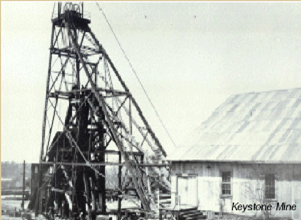Founded in 1851 from many claims. One of the most profitable and longest-running mines. Joining with South Spring Hill Mine working till 1942. East shaft worked until 1952. Reached a depth of 2,680’. Employed 100 men and produced $24,000,000 in gold.
The foundations are located just a few steps south of the south end of the parking lot on the east side of Main Street (Old Highway 49).
The crumbling stone walls are all that remain to mark the site of the Wildman mine’s easternmost shaft, known as the Emerson. The Wildman mine, in combination with the Mahoney, is credited with a production of $5 million in gold.
Keystone is located within the city limits of Amador City. During the early period of operations, much high-grade ore was produced so that dividends as high as $550 per share per month were declared.
By 1888 most of the high-grade ore had been exhausted. Mining operations continued until the mine closed in 1919. From 1911 to 1919, the Keystone Mining Company operated the mine. In 1920 the company gained control of the South spring Hill mine adjoining the Keystone property on the east side.
In 1933 the Keystone was reopened by Keystone Mines Syndicate. Production was underway by 1935 and continued until the fall of 1942 when the mine was closed down by governmental order L-208.
Ore was first crunched at the Keystone and then trucked to the Original Amador mine where it was milled and cyanided. Just prior to the closing of the mine in 1942, about 100 men were employed at the mine and mill.
In 1920 the Keystone Mining Company gained control of the South Spring Hill mine which adjoins the property to the east; however, very little was done until 1933 when the Keystone was re-opened by the Keystone Mines Syndicate. After two years of rehabilitation and development work production was underway in 1925 and continued until the fall of 1942, when the Keystone, as all other gold mines, was closed down by government order. During this final seven years of operation about one million dollars in gold was produced.
With the exception of a small amount of work done in 1952 in the neighboring Wonder mine just east of the main shaft, nothing has been done at the Keystone since the beginning of World War II.
Other than that little else remains. The surface works have been junked. The shaft has caved. The famous old Keystone is now just another abandoned mine.


